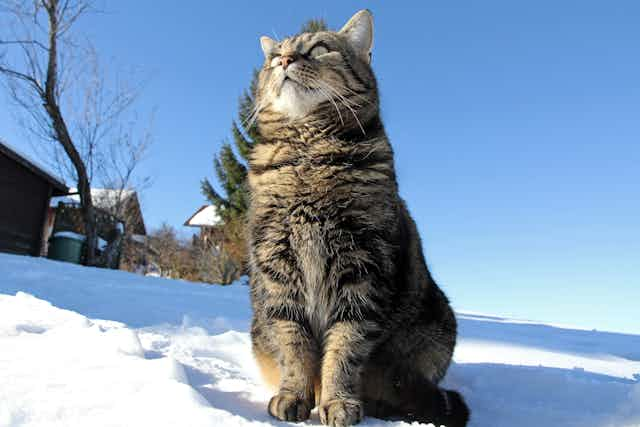Humans may have had pet cats for as long as 9,500 years. In 2004, archaeologists in Cyprus found a complete cat skeleton buried in a Stone Age village. Given that Cyprus has no native wildcats, the animal (or perhaps its ancestors) must have been brought to the island by humans all those millennia ago.
Yet despite our long history of keeping pet cats and their popularity today, felines aren’t the easiest of animals to domesticate (as anyone who’s felt a cat’s cold shoulder might agree). There is also little evidence in the archaeological record to show how cats became our friends and went on to spread around the world.
Now a new DNA study published in Ecology and Evolution suggests how cats may have followed the development of Western civilisation along land and sea trade routes. This process was eventually helped by a more concerted breeding attempt in the 18th century, creating the much-loved domestic short-haired or “tabby” cat we know today.
While the origin of the domesticated cat is still a mystery, it seems likely the process of becoming pets took a very long time. It seems that, because cats are so independent, territorial and, at times, downright antisocial, they were not so easy to domesticate as the co-operative, pack-orientated wolf. It’s likely that cats lived around humans for many centuries before succumbing to the lure of the fire and the cushion, and coming in from the cold to become true companions to humans.

The cat found in Cyprus corresponds to the Neolithic period of around 10,000 BC to 4,000 BC and the agricultural revolution. This was when people were beginning to settle down and become farmers instead of carrying on the nomadic hunter-gatherer existence that humans had followed for the previous 200,000 years or so. An earlier DNA study of other ancient remains confirms that domestic cats first emerged in what archaeologists call the Near East, the land at the eastern end of the Mediterranean where some of the first human civilisations emerged.
Of course, farming brings its own problems, including infestations of rats and mice, so perhaps it’s not surprising that it is at this time that we see the first occurrence of a cat buried in a human grave. It’s not hard to imagine that early farmers might have encouraged cats to stay around by helping them out with food during lean times of the year, and allowing them to come into their houses.
The gaps in the archaeological record mean that, after the Cyprus remains, evidence for domestic cats doesn’t appear again for thousands of years. More cat graves then start to appear among ancient Egyptian finds (although there is also evidence for tame cats in Stone Age China). It was in Egypt that cats really got their furry paws under the table and became not just part of the family but objects of religious worship.
To track the spread of the domestic cat, the authors of the new study examined DNA taken from bones and teeth of ancient cat remains. They also studied samples from the skin and hair of mummified Egyptian cats (and you thought emptying the litter tray was bad enough).
They found that all modern cats have ancestors among the Near Eastern and Egyptian cats, although the contributions of these two groups to the gene pool of today’s cats probably happened at different times. From there, the DNA analysis suggests domestic cats spread out over a period of around 1,300 years to the 5th century AD, with remains recorded in Bulgaria, Turkey and Jordan.

Over the next 800 years, domestic cats spread further into northern Europe. But it wasn’t until the 18th century that the traditional “mackerel” coat of the wildcat began to change in substantial numbers to the blotched pattern that we see in many modern tabbies. This suggests that, at that time, serious efforts to breed cats for appearance began – perhaps the origin of modern cat shows.
Another interesting finding is that domestic cats from earliest times, when moved around by humans to new parts of the world, promptly mated with local wildcats and spread their genes through the population. And, in the process, they permanently changed the gene pool of cats in the area.
This has particular relevance to today’s efforts to protect the endangered European wildcat, because conservationists often think interbreeding with domestic cats is one of the greatest threats to the species. If this has been happening all over the old world for the past 9,000 or so years, then perhaps it’s time to stop worrying about wildcats breeding with local moggies. This study suggests that none of the existing species of non-domesticated cats is likely to be pure. In fact, cats’ ability to interbreed has helped them conquer the world.

